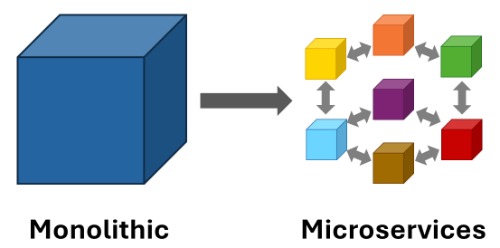Legacy systems are often huge, monolithic applications developed over a long period. These applications can become hard to maintain and are an inefficient use of resources, signaling that it may be time to migrate to cloud infrastructure and take advantage of modern microservice technology. Once deployed, microservice architecture helps organizations remain flexible and efficient while isolating services and functionalities. Today, a variety of available cloud solutions can enable companies of any size to transition to cloud-based microservice architectures.

Microservices
The increased flexibility and simplification offered by microservices architectures represent significant advantages. Microservices are designed and developed to keep services isolated and independent of each other. While there are cloud technologies and databases that allow these services to communicate and share information internally, the primary goal is to isolate services.
A significant benefit is the ability to scale applications up or down. For example, suppose there is a sudden load to the add operation. In that case, microservices architectures enable load balancing to distribute traffic across servers to improve system performance without expanding unused operations like updating or deleting. Users only pay for what is used, saving both resources and costs.
Because services are kept independent, a microservice architecture can integrate emerging technologies more easily. New features and functions can be developed and implemented without impacting other services. In monolithic architectures, services are more closely tied, making it challenging to make updates or changes without risking unintentional impacts on non-target systems. Applications in monolithic architectures might be easy to develop and manage, but they are tightly coupled, which makes updates challenging since applications tend to get bigger over time and, at some point, it becomes hard to make any changes at all.
Implementing or transitioning to a microservices architecture does require time, knowledge, and investment. Effective architectures necessitate an understanding of the latest cutting-edge cloud features and technologies, and since each service has its lifecycle of development, deployment, and maintenance, there is additional overhead. Still, when done correctly, this higher initial cost will improve efficiency, especially at the production level. Microservice architectures provide flexibility so organizations can quickly expand different services or features as needed.
Cloud Solutions
The rise of cloud computing has enabled more widespread adoption of microservices architecture, especially with on-demand scalability. As with microservices, one of cloud infrastructure’s significant benefits is that it allows businesses to scale their computing resources up or down as needed. Cloud-based microservices often include logging and tracing information by default, providing organizations with more information than a monolithic architecture about how the programs are being used.
Data is an increasingly valuable resource for organizations in all industries, and they are gathering and generating increasing amounts of data. In a recent article, McKinsey predicted widespread “data ubiquity” by 2030, which refers to the increasing volume and access to up-to-date data and its progressively important role in nearly all processes, systems, and decisions organizations make.
According to a report from Deloitte on the current and future use of the cloud, 86 percent of surveyed organizations already use the cloud for data analytics and management, and 74 percent use it in conjunction with artificial intelligence (AI) or machine learning (ML). AI and ML algorithms are among the best tools available for finding useful patterns in large data, and the out-of-the-box AI capabilities offered by cloud providers allow businesses of any size to harness the power of these emerging technologies to garner insights immediately. Once a company becomes more robust and established, building a custom AI or ML model with custom logic may offer a better return on the investment (ROI). In the meantime, these in-built cloud solutions can help organizations stay on top of changing technology trends.
Microservices Adoption
The most critical step for organizations transitioning from a monolithic to a microservice architecture is to ensure all applications and business operations are properly decoupled. While cloud technology is a vital part of a microservices approach, simply uploading existing systems does not mean it has been transitioned to microservices. For each service to be individually deployable, updatable, and scaled up or down, organizations first need to decouple any tightly tangled legacy services.
Organizations can think big but implement small. While innovative and efficient goals are crucial, applications are thought of in isolated, granular terms. Independent services are the foundation of microservice architecture. Adding too many features into a single application will quickly revert organizations to a monolithic framework. Instead, new services can be added as needed.
Microservices architectures are increasingly common and many large organizations like Netflix, Uber, and Spotify. In a Gartner survey, nearly three-quarters of respondents said their organization already uses microservices. Small and midsize companies concerned about the challenge of migrating to microservices don’t need to reinvent the wheel. For example, last year, the state of Utah’s Office of Recovery Services (ORS) migrated its case management and accounting system entirely into a public cloud. The agency used an automated refactoring tool to migrate both the code and data and now has access to various cloud-native technologies, including AI, process automation, and data analytics. Like ORS, organizations can utilize the cloud-based tools and solutions cloud providers have developed to simplify the transition to microservices and cloud systems.
In the end, it is critical for organizations to make decisions based on their unique needs. For any company, regardless of size or industry, transitioning to a cloud-based microservice architecture is worth consideration. Microservices architectures are not dependent on a single or specific resource for the whole system, enabling organizations to be more agile and innovative. With the cloud, companies can access out-of-the-box capabilities like AI, increased data, and advanced security features that would require significant investment to build themselves.











